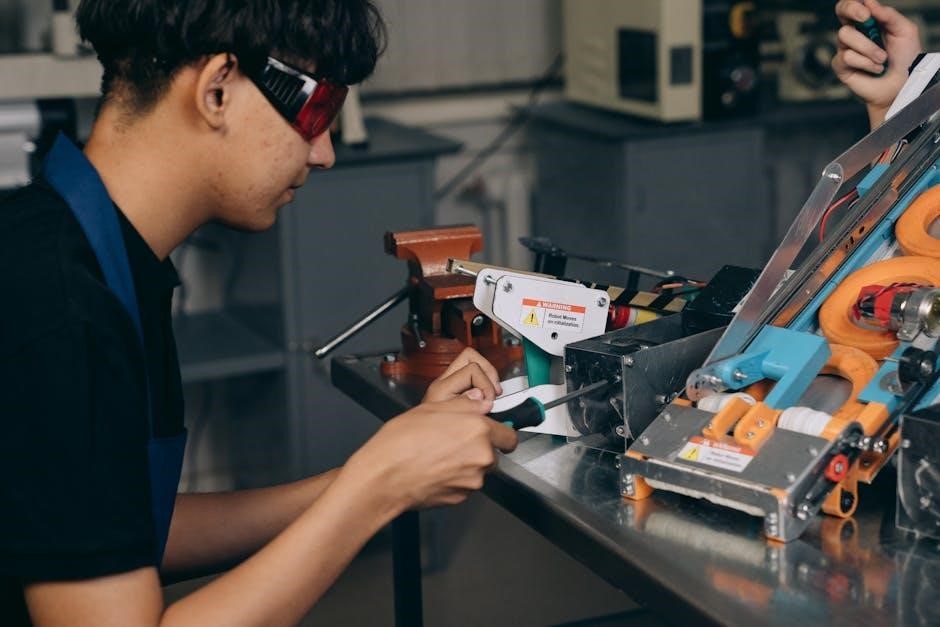
machine learning with r quick start guide
Machine learning with R offers a powerful, accessible approach to data analysis and modeling; This quick start guide simplifies the process for both beginners and experienced users.
1.1. Overview of Machine Learning
Machine learning is a subset of artificial intelligence that involves training algorithms to learn patterns from data and make predictions or decisions. It enables systems to improve their performance on a task without explicit programming. Machine learning applications span classification, regression, clustering, and more. Supervised learning uses labeled data, while unsupervised learning discovers hidden patterns in unlabeled data. It is widely applied in areas like natural language processing, image recognition, and predictive analytics. With R, machine learning becomes accessible, allowing users to build models and derive insights efficiently. This overview provides a foundation for understanding the concepts and techniques explored in subsequent sections.

1.2. Why Use R for Machine Learning?
R is a powerful and versatile programming language ideal for machine learning due to its open-source nature and extensive libraries. It provides robust tools for data manipulation, visualization, and modeling, making it a favorite among data scientists. R’s simplicity and flexibility allow users to quickly implement complex algorithms, from regression to advanced techniques like random forests and support vector machines. Its vast ecosystem, including packages like caret, dplyr, and ggplot2, streamlines workflows for data preprocessing, analysis, and visualization. Additionally, R’s active community ensures continuous updates and resources, making it a reliable choice for both beginners and experts. Its ability to handle both supervised and unsupervised learning tasks, combined with its scalability, makes R an excellent platform for machine learning projects. This accessibility and richness of resources make R a preferred tool for gaining insights from data efficiently.
1.3. Quick Start Guide to Setting Up R for Machine Learning

Setting Up Your Environment
Setting up your R environment is crucial for machine learning. Install R and RStudio, then add essential packages like tidyverse and caret to enhance functionality. Explore built-in datasets for practice.
2.1. Installing R and RStudio
Installing R and RStudio is the first step in your machine learning journey. Download R from the official website and select the appropriate version for your operating system. Once installed, download RStudio, a user-friendly IDE that simplifies coding. Follow the installation prompts carefully to ensure a smooth setup. After installation, open RStudio and familiarize yourself with its interface, including the console, script editor, and environment pane. These tools will be essential for executing code, managing projects, and visualizing data. Proper installation ensures you have a stable environment for running machine learning algorithms and packages like caret and dplyr. This setup is the foundation for all subsequent tasks.
2.2. Essential Packages for Machine Learning in R
To get started with machine learning in R, you’ll need to install essential packages that provide foundational functionality. The caret package is indispensable for building and testing regression and classification models, offering tools for data splitting and model tuning. dplyr and tidyr are crucial for data manipulation and cleaning, enabling efficient data preprocessing. For advanced modeling, tidymodels provides a modern, consistent interface for machine learning workflows. Additionally, randomForest and e1071 are key for specific algorithms like decision trees and SVMs. These libraries collectively provide tools for data handling, model development, and validation, ensuring you have everything needed to tackle machine learning projects effectively. Install them using install.packages to unlock their full potential.
2.3. Configuring Your R Environment
Configuring your R environment ensures a smooth and efficient workflow for machine learning tasks. Begin by setting up your working directory using setwd to organize your files. Customize your RStudio interface by adjusting themes and keyboard shortcuts for better productivity. Install version control tools like git to manage your projects effectively. Additionally, configure your .Rprofile file to load essential libraries automatically on startup. Familiarize yourself with RStudio’s built-in tools, such as the Environment panel for data exploration and the Console for interactive coding. Properly structuring your project directories and leveraging RStudio’s features will streamline your machine learning processes, making it easier to manage datasets, scripts, and outputs. A well-configured environment enhances your efficiency and focus on model development and analysis.

Loading and Understanding Your Data
3.1. Importing Data into R
3.2. Understanding Data Structure with Statistical Summaries
Data visualization is a cornerstone of machine learning in R, enabling insights into data distributions, relationships, and patterns. Popular libraries like ggplot2 and plotly simplify creating interactive and visually appealing plots. Start with basic plots such as scatterplots using ggplot(aes(x, y)) + geom_point to explore relationships between variables. Bar charts with geom_bar help visualize categorical data distributions. Boxplots are ideal for understanding variance and outliers. Heatmaps, created with heatmap, reveal complex data interactions. These visualizations help identify trends, correlations, and anomalies, guiding preprocessing and model selection. For instance, visualizing missing data with mdsplot or distributions with hist aids in understanding data quality. Effective visualization accelerates exploratory data analysis, making it easier to prepare data for machine learning models and interpret results. By leveraging R’s robust visualization tools, you can transform raw data into actionable insights.

Data Preprocessing Techniques
Data preprocessing is essential for machine learning success. Techniques include handling missing data, normalization, scaling, and feature engineering to prepare datasets for modeling.
4.1. Handling Missing Data
Missing data is a common issue in machine learning that can significantly impact model performance. In R, identifying and addressing missing values is crucial for accurate analysis.
Use the is.na function to detect missing values, while sum(is.na(dataset)) provides a count. Strategies include removing rows/columns with missing values using na.omit or imputing with mean/median using mean or median.
For advanced handling, the missForest package offers robust imputation. Always evaluate the impact of missing data on your model and choose the most appropriate method based on the dataset and context.
Best practices include avoiding over-imputation and ensuring imputed data aligns with the distribution of existing values. Regularly validate imputed datasets to maintain model reliability and performance.
4.2. Data Normalization and Scaling
Data normalization and scaling are essential steps in preparing datasets for machine learning models. These techniques ensure that features with larger scales do not dominate the model.
In R, normalization can be performed using the dplyr package or the recipes package, which provides a straightforward syntax for preprocessing. Standardization, a common scaling method, transforms data to have a mean of 0 and a standard deviation of 1 using scale.
For normalization, the rangeScaling function from the recipes package scales data between specified bounds, often 0 and 1. Use recipe and step_range for this purpose.
Scaling is particularly important for algorithms like SVM and neural networks, which are sensitive to the scale of features. Always apply these transformations before splitting data into training and test sets.
Best practices include reapplying the same scaling parameters to new, unseen data to maintain consistency and model performance.
4.3. Feature Engineering for Machine Learning
Feature engineering is a critical step in machine learning that involves creating and selecting relevant features to improve model performance. In R, this process can be streamlined using various techniques.
Categorical variables can be transformed using dummies or factorize, while numeric features may require normalization or scaling. Missing values should be handled appropriately, either by imputation or removal.
Dimensionality reduction techniques like PCA (prcomp) can simplify datasets. Feature engineering also involves creating interaction terms, transforming variables (e.g., log or square root), and encoding non-linear relationships.
Domain knowledge is essential for crafting meaningful features. Tools like recipes and caret provide robust frameworks for feature engineering. Regularly iterate and refine features based on model performance to achieve optimal results.

Exploratory Data Analysis (EDA)

EDA involves understanding data distributions, identifying outliers, and visualizing relationships to uncover patterns and insights. Use R’s visualization tools and statistical summaries to inform preprocessing and modeling decisions effectively.
5.1. Identifying Patterns in Data
Identifying patterns in data is a critical step in exploratory data analysis (EDA). Using R, you can visualize distributions, trends, and relationships to uncover hidden structures. Tools like ggplot2 and dplyr help create interactive and dynamic visualizations. Scatter plots, box plots, and heatmaps are effective for spotting correlations, outliers, and clusters. Additionally, statistical methods like mean, median, and correlation coefficients provide quantitative insights. By examining variables and their interactions, you can identify patterns that inform feature engineering and model selection. For example, clustering algorithms like k-means can reveal natural groupings in data. Documenting these patterns ensures a robust foundation for machine learning workflows.
5.2. Correlation Analysis
Correlation analysis is essential for understanding relationships between variables in your dataset. In R, you can use the cor function to compute pairwise correlations, which measure the strength and direction of linear relationships. Pearson correlation is commonly used for continuous variables, while Spearman and Kendall correlations are suitable for non-linear or ordinal data. Visualizing correlations with heatmaps or matrices helps identify patterns and strengths. Tools like ggplot2 and corrplot simplify this process. High correlations may indicate redundant features or important predictors for machine learning models. Conversely, low correlations might suggest irrelevant variables. This step is crucial for feature selection and dimensionality reduction, ensuring models are trained on meaningful data. Correlation analysis also aids in understanding variable interactions, guiding feature engineering efforts.
5.3. Dimensionality Reduction Techniques
Dimensionality reduction is a crucial step in machine learning that simplifies datasets by reducing the number of features while preserving essential information. This process enhances model performance, reduces computational demands, and improves interpretability. In R, several techniques are available:
- Principal Component Analysis (PCA): Transforms data into principal components, capturing most variance. Widely used for its effectiveness and simplicity.
- t-Distributed Stochastic Neighbor Embedding (t-SNE): Excels at visualizing high-dimensional data in lower dimensions, aiding in pattern discovery.
- Factor Analysis: Similar to PCA but based on latent variables, useful for identifying underlying factors.
- Multidimensional Scaling (MDS): Reduces dimensions by preserving pairwise distances, useful for maintaining data structure.
In R, these techniques are implemented using functions like prcomp for PCA and tsne for t-SNE. By applying these methods, you can create more efficient models and uncover hidden data structures, making dimensionality reduction an indispensable tool in your machine learning workflow.

Basic Machine Learning Concepts
Discover the fundamentals of machine learning, including supervised and unsupervised learning, regression, classification, and key algorithms essential for building robust predictive models in R.

6.1. Supervised vs. Unsupervised Learning
Machine learning algorithms are broadly categorized into supervised and unsupervised learning. Supervised learning involves training models on labeled data, where the algorithm learns from input-output pairs to make predictions. For instance, linear regression and logistic regression are classic examples. On the other hand, unsupervised learning deals with unlabeled data, aiming to uncover hidden patterns or intrinsic structures, such as clustering. Understanding the differences is crucial as each approach addresses distinct problems. R offers extensive libraries like caret for supervised methods and cluster for unsupervised techniques. This chapter provides a clear foundation in these concepts, enabling you to choose the right approach for your data science tasks.
Regression analysis is a fundamental supervised learning technique used to model relationships between variables. In R, it is widely applied for predicting continuous outcomes. Linear regression is the most common type, where a linear model is fitted to data. Logistic regression, a variant, is used for binary classification. R provides robust functions like lm for linear regression and glm for generalized linear models. These tools enable users to estimate coefficients, assess model fit, and make predictions. Regression analysis is essential for understanding variable relationships and is a cornerstone of machine learning workflows. By leveraging R’s built-in capabilities, users can easily implement and interpret regression models, making it a vital skill for data scientists.
6.3; Classification in Machine Learning
Classification is a supervised learning technique used to predict categorical outcomes. It involves training models to assign data points to predefined classes. In R, classification is commonly performed using algorithms like logistic regression, decision trees, and random forests. Logistic regression, implemented via glm, is ideal for binary classification, while methods like randomForest handle multi-class problems effectively. Classification models are evaluated using metrics such as accuracy, precision, and recall. R’s caret package simplifies model tuning and comparison. These techniques are widely applied in real-world scenarios, such as spam detection, customer segmentation, and medical diagnosis. By leveraging R’s robust libraries, users can build and deploy classification models to solve complex problems efficiently.

Building Machine Learning Models
Learn to implement essential algorithms like linear regression, logistic regression, and decision trees in R. Utilize packages like caret for model tuning and evaluation to achieve accurate predictions.
7.1. Linear Regression in R
Ensure your data meets assumptions such as linearity, independence, and homoscedasticity. Use plot to visualize residual diagnostics. For better visualization, leverage ggplot2 to create informative plots. This approach simplifies model building and interpretation, making linear regression a great starting point for machine learning in R.
7.2. Logistic Regression for Classification
Logistic regression is a powerful algorithm for binary classification tasks in R. Use the glm function with the binomial family to model probabilities. For example, glm(outcome ~ predictor, family = "binomial", data = df) predicts a binary outcome. Evaluate model performance using metrics like accuracy, precision, and recall, accessible via the confusionMatrix function from the caret package. Interpret coefficients using exp to convert them into odds ratios. Visualize results with ROC curves using the ROCR package or confusion matrices with ggplot2. This approach is ideal for classification tasks, providing clear and actionable insights in R.
7.3. Decision Trees and Random Forests
Decision trees are a fundamental machine learning model in R, providing clear, interpretable results. Use the rpart package to build trees with rpart, and visualize them with rpart.plot. For classification, set method = "class", and for regression, use method = "anova". Decision trees handle categorical and numerical data seamlessly. To avoid overfitting, prune trees using rpart.prune. For improved performance, use random forests via the randomForest package, which combines multiple trees to reduce variance. Train models with randomForest(outcome ~ predictors, data = df) and tune parameters like ntree and mtry for optimal results. Use varImpPlot to identify key predictors. These methods are powerful for both classification and regression tasks, offering robust and accurate models in R.
7.4. Support Vector Machines (SVM)
Support Vector Machines (SVM) are powerful supervised learning models for classification and regression. In R, SVMs are implemented using the kernlab package. Use ksvm to train models, specifying parameters like kernel (e.g., linear, polynomial, or radial basis function) and C (cost parameter). For classification, SVM finds the optimal hyperplane to separate classes. For regression, it predicts continuous outcomes. Train a model with ksvm(target ~ features, data = df, kernel = "rbfdot", C = 1). Tune parameters using tuneGrid and cross-validation for optimal performance. SVMs excel with high-dimensional data and non-linear relationships but can be computationally intensive. Use predict for new data and evaluate with metrics like accuracy or MSE. SVMs are versatile and widely used in machine learning applications.
7.5. Model Tuning and Optimization
Model tuning and optimization are critical steps to enhance performance and accuracy. Start by identifying hyperparameters that significantly impact your model. Use techniques like grid search or random search to test different combinations. In R, the caret package provides a unified interface for tuning models. Use train with a tuneGrid to specify parameter ranges. Cross-validation ensures reliable performance assessment. For example, train(Species ~ ., data = iris, method = "rf", tuneGrid = expand.grid(mtry = 2:5), trControl = trainControl(method = "cv", number = 5)). Evaluate models using metrics like accuracy, RMSE, or AUC. Compare results to select the best-performing model. Regularization techniques, such as Lasso or Ridge regression, can further optimize model complexity. Automated tools like autoML or MLR streamline the tuning process. Always validate final models on unseen data to ensure generalizability.

Leave a Reply
You must be logged in to post a comment.